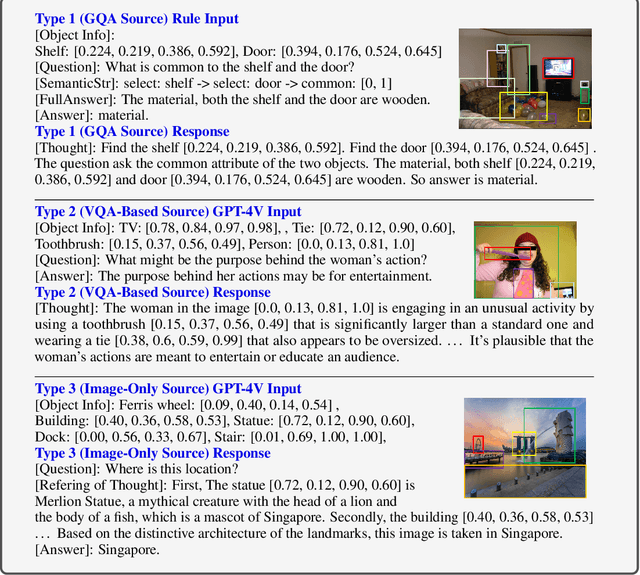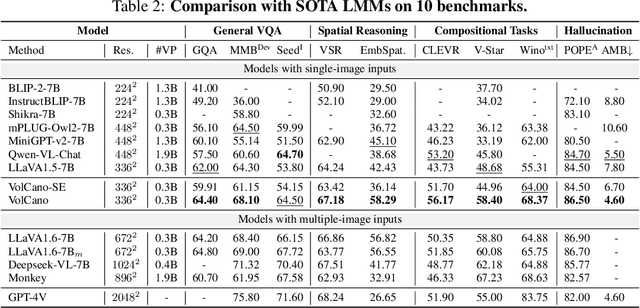Jiwen Zhang
TextHawk2: A Large Vision-Language Model Excels in Bilingual OCR and Grounding with 16x Fewer Tokens
Oct 07, 2024Abstract:Reading dense text and locating objects within images are fundamental abilities for Large Vision-Language Models (LVLMs) tasked with advanced jobs. Previous LVLMs, including superior proprietary models like GPT-4o, have struggled to excel in both tasks simultaneously. Moreover, previous LVLMs with fine-grained perception cost thousands of tokens per image, making them resource-intensive. We present TextHawk2, a bilingual LVLM featuring efficient fine-grained perception and demonstrating cutting-edge performance across general-purpose, OCR, and grounding tasks with 16 times fewer image tokens. Critical improvements include: (1) Token Compression: Building on the efficient architecture of its predecessor, TextHawk2 significantly reduces the number of tokens per image by 16 times, facilitating training and deployment of the TextHawk series with minimal resources. (2) Visual Encoder Reinforcement: We enhance the visual encoder through LVLM co-training, unlocking its potential for previously unseen tasks like Chinese OCR and grounding. (3) Data Diversity: We maintain a comparable scale of 100 million samples while diversifying the sources of pre-training data. We assess TextHawk2 across multiple benchmarks, where it consistently delivers superior performance and outperforms closed-source models of similar scale, such as achieving 78.4% accuracy on OCRBench, 81.4% accuracy on ChartQA, 89.6% ANLS on DocVQA, and 88.1% accuracy@0.5 on RefCOCOg-test.
VoCoT: Unleashing Visually Grounded Multi-Step Reasoning in Large Multi-Modal Models
May 28, 2024



Abstract:While large multi-modal models (LMMs) have exhibited impressive capabilities across diverse tasks, their effectiveness in handling complex tasks has been limited by the prevailing single-step reasoning paradigm. To this end, this paper proposes VoCoT, a multi-step Visually grounded object-centric Chain-of-Thought reasoning framework tailored for inference with LMMs. VoCoT is characterized by two key features: (1) object-centric reasoning paths that revolve around cross-modal shared object-level information, and (2) visually grounded representation of object concepts in a multi-modal interleaved and aligned manner, which effectively bridges the modality gap within LMMs during long-term generation. Additionally, we construct an instruction dataset to facilitate LMMs in adapting to reasoning with VoCoT. By introducing VoCoT into the prevalent open-source LMM architecture, we introduce VolCano. With only 7B parameters and limited input resolution, VolCano demonstrates excellent performance across various scenarios, surpassing SOTA models, including GPT-4V, in tasks requiring complex reasoning. Our code, data and model will be available at https://github.com/RupertLuo/VoCoT.
DELAN: Dual-Level Alignment for Vision-and-Language Navigation by Cross-Modal Contrastive Learning
Apr 02, 2024Abstract:Vision-and-Language navigation (VLN) requires an agent to navigate in unseen environment by following natural language instruction. For task completion, the agent needs to align and integrate various navigation modalities, including instruction, observation and navigation history. Existing works primarily concentrate on cross-modal attention at the fusion stage to achieve this objective. Nevertheless, modality features generated by disparate uni-encoders reside in their own spaces, leading to a decline in the quality of cross-modal fusion and decision. To address this problem, we propose a Dual-levEL AligNment (DELAN) framework by cross-modal contrastive learning. This framework is designed to align various navigation-related modalities before fusion, thereby enhancing cross-modal interaction and action decision-making. Specifically, we divide the pre-fusion alignment into dual levels: instruction-history level and landmark-observation level according to their semantic correlations. We also reconstruct a dual-level instruction for adaptation to the dual-level alignment. As the training signals for pre-fusion alignment are extremely limited, self-supervised contrastive learning strategies are employed to enforce the matching between different modalities. Our approach seamlessly integrates with the majority of existing models, resulting in improved navigation performance on various VLN benchmarks, including R2R, R4R, RxR and CVDN.
Android in the Zoo: Chain-of-Action-Thought for GUI Agents
Mar 05, 2024



Abstract:Large language model (LLM) leads to a surge of autonomous GUI agents for smartphone, which completes a task triggered by natural language through predicting a sequence of actions of API. Even though the task highly relies on past actions and visual observations, existing studies typical consider little semantic information carried out by intermediate screenshots and screen operations. To address this, this work presents Chain-of-Action-Thought (dubbed CoAT), which takes the description of the previous actions, the current screen, and more importantly the action thinking of what actions should be performed and the outcomes led by the chosen action. We demonstrate that, in a zero-shot setting upon an off-the-shell LLM, CoAT significantly improves the goal progress compared to standard context modeling. To further facilitate the research in this line, we construct a benchmark Android-In-The-Zoo (AitZ), which contains 18,643 screen-action pairs together with chain-of-action-thought annotations. Experiments show that fine-tuning a 200M model on our AitZ dataset achieves on par performance with CogAgent-Chat-18B.
ReForm-Eval: Evaluating Large Vision Language Models via Unified Re-Formulation of Task-Oriented Benchmarks
Oct 17, 2023



Abstract:Recent years have witnessed remarkable progress in the development of large vision-language models (LVLMs). Benefiting from the strong language backbones and efficient cross-modal alignment strategies, LVLMs exhibit surprising capabilities to perceive visual signals and perform visually grounded reasoning. However, the capabilities of LVLMs have not been comprehensively and quantitatively evaluate. Most existing multi-modal benchmarks require task-oriented input-output formats, posing great challenges to automatically assess the free-form text output of LVLMs. To effectively leverage the annotations available in existing benchmarks and reduce the manual effort required for constructing new benchmarks, we propose to re-formulate existing benchmarks into unified LVLM-compatible formats. Through systematic data collection and reformulation, we present the ReForm-Eval benchmark, offering substantial data for evaluating various capabilities of LVLMs. Based on ReForm-Eval, we conduct extensive experiments, thoroughly analyze the strengths and weaknesses of existing LVLMs, and identify the underlying factors. Our benchmark and evaluation framework will be open-sourced as a cornerstone for advancing the development of LVLMs.
Breaking Down the Task: A Unit-Grained Hybrid Training Framework for Vision and Language Decision Making
Jul 16, 2023



Abstract:Vision language decision making (VLDM) is a challenging multimodal task. The agent have to understand complex human instructions and complete compositional tasks involving environment navigation and object manipulation. However, the long action sequences involved in VLDM make the task difficult to learn. From an environment perspective, we find that task episodes can be divided into fine-grained \textit{units}, each containing a navigation phase and an interaction phase. Since the environment within a unit stays unchanged, we propose a novel hybrid-training framework that enables active exploration in the environment and reduces the exposure bias. Such framework leverages the unit-grained configurations and is model-agnostic. Specifically, we design a Unit-Transformer (UT) with an intrinsic recurrent state that maintains a unit-scale cross-modal memory. Through extensive experiments on the TEACH benchmark, we demonstrate that our proposed framework outperforms existing state-of-the-art methods in terms of all evaluation metrics. Overall, our work introduces a novel approach to tackling the VLDM task by breaking it down into smaller, manageable units and utilizing a hybrid-training framework. By doing so, we provide a more flexible and effective solution for multimodal decision making.
Robotic Assembly Control Reconfiguration Based on Transfer Reinforcement Learning for Objects with Different Geometric Features
Nov 04, 2022



Abstract:Robotic force-based compliance control is a preferred approach to achieve high-precision assembly tasks. When the geometric features of assembly objects are asymmetric or irregular, reinforcement learning (RL) agents are gradually incorporated into the compliance controller to adapt to complex force-pose mapping which is hard to model analytically. Since force-pose mapping is strongly dependent on geometric features, a compliance controller is only optimal for current geometric features. To reduce the learning cost of assembly objects with different geometric features, this paper is devoted to answering how to reconfigure existing controllers for new assembly objects with different geometric features. In this paper, model-based parameters are first reconfigured based on the proposed Equivalent Theory of Compliance Law (ETCL). Then the RL agent is transferred based on the proposed Weighted Dimensional Policy Distillation (WDPD) method. The experiment results demonstrate that the control reconfiguration method costs less time and achieves better control performance, which confirms the validity of proposed methods.
Local Connection Reinforcement Learning Method for Efficient Control of Robotic Peg-in-Hole Assembly
Oct 24, 2022



Abstract:Traditional control methods of robotic peg-in-hole assembly rely on complex contact state analysis. Reinforcement learning (RL) is gradually becoming a preferred method of controlling robotic peg-in-hole assembly tasks. However, the training process of RL is quite time-consuming because RL methods are always globally connected, which means all state components are assumed to be the input of policies for all action components, thus increasing action space and state space to be explored. In this paper, we first define continuous space serialized Shapley value (CS3) and construct a connection graph to clarify the correlativity of action components on state components. Then we propose a local connection reinforcement learning (LCRL) method based on the connection graph, which eliminates the influence of irrelevant state components on the selection of action components. The simulation and experiment results demonstrate that the control strategy obtained through LCRL method improves the stability and rapidity of the control process. LCRL method will enhance the data-efficiency and increase the final reward of the training process.
Curriculum Learning for Vision-and-Language Navigation
Nov 14, 2021



Abstract:Vision-and-Language Navigation (VLN) is a task where an agent navigates in an embodied indoor environment under human instructions. Previous works ignore the distribution of sample difficulty and we argue that this potentially degrade their agent performance. To tackle this issue, we propose a novel curriculum-based training paradigm for VLN tasks that can balance human prior knowledge and agent learning progress about training samples. We develop the principle of curriculum design and re-arrange the benchmark Room-to-Room (R2R) dataset to make it suitable for curriculum training. Experiments show that our method is model-agnostic and can significantly improve the performance, the generalizability, and the training efficiency of current state-of-the-art navigation agents without increasing model complexity.
 Add to Chrome
Add to Chrome Add to Firefox
Add to Firefox Add to Edge
Add to Edge